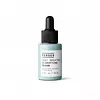What's inside
What's inside
 Key Ingredients
Key Ingredients

 Benefits
Benefits

 Concerns
Concerns

 Ingredients Side-by-side
Ingredients Side-by-side

Water
Skin ConditioningGlycerin
HumectantNiacinamide
SmoothingSalix Nigra Bark Extract
Skin ProtectingZinc Gluconate
Skin ConditioningSodium Hyaluronate
HumectantSalicylic Acid
MaskingAesculus Hippocastanum Seed Extract
Skin ConditioningCeramide AP
Skin Conditioning1,2-Hexanediol
Skin ConditioningButylene Glycol
HumectantPhenoxyethanol
PreservativePEG-40 Hydrogenated Castor Oil
EmulsifyingHydroxyethylcellulose
Emulsion StabilisingYeast Extract
Skin ConditioningGlyceryl Acrylate/Acrylic Acid Copolymer
HumectantTrisodium Ethylenediamine Disuccinate
Ammonium Glycyrrhizate
MaskingBiotin
AntiseborrhoeicPanthenol
Skin ConditioningPropylene Glycol
HumectantCaffeine
Skin ConditioningWater, Glycerin, Niacinamide, Salix Nigra Bark Extract, Zinc Gluconate, Sodium Hyaluronate, Salicylic Acid, Aesculus Hippocastanum Seed Extract, Ceramide AP, 1,2-Hexanediol, Butylene Glycol, Phenoxyethanol, PEG-40 Hydrogenated Castor Oil, Hydroxyethylcellulose, Yeast Extract, Glyceryl Acrylate/Acrylic Acid Copolymer, Trisodium Ethylenediamine Disuccinate, Ammonium Glycyrrhizate, Biotin, Panthenol, Propylene Glycol, Caffeine
Salicylic Acid 1.5%
MaskingWater
Skin ConditioningSodium Cocoyl Isethionate
CleansingStearic Acid
CleansingRosa Centifolia Flower Water
Skin ConditioningPropanediol
SolventGlycerin
HumectantGlyceryl Stearate Se
EmulsifyingCoconut Acid
CleansingPhenoxyethanol
PreservativePyrus Malus Fruit Extract
Skin ConditioningSodium Hydroxide
BufferingHydroxyacetophenone
AntioxidantSodium Isethionate
CleansingXanthan Gum
EmulsifyingMenthoxypropanediol
MaskingEthylhexylglycerin
Skin ConditioningCI 77891
Cosmetic ColorantTanacetum Annuum Flower Oil
MaskingTetrasodium Glutamate Diacetate
Mica
Cosmetic ColorantBiosaccharide Gum-1
HumectantMicrocitrus Australasica Fruit Extract
CI 77510
Cosmetic ColorantCitric Acid
BufferingPotassium Sorbate
PreservativeSodium Benzoate
MaskingPropylene Glycol
HumectantTin Oxide
AbrasiveSodium Glycolate
BufferingSodium Formate
BufferingLactobacillus Ferment Extract
Skin ConditioningSalicylic Acid 1.5%, Water, Sodium Cocoyl Isethionate, Stearic Acid, Rosa Centifolia Flower Water, Propanediol, Glycerin, Glyceryl Stearate Se, Coconut Acid, Phenoxyethanol, Pyrus Malus Fruit Extract, Sodium Hydroxide, Hydroxyacetophenone, Sodium Isethionate, Xanthan Gum, Menthoxypropanediol, Ethylhexylglycerin, CI 77891, Tanacetum Annuum Flower Oil, Tetrasodium Glutamate Diacetate, Mica, Biosaccharide Gum-1, Microcitrus Australasica Fruit Extract, CI 77510, Citric Acid, Potassium Sorbate, Sodium Benzoate, Propylene Glycol, Tin Oxide, Sodium Glycolate, Sodium Formate, Lactobacillus Ferment Extract
 Reviews
Reviews

Ingredients Explained
These ingredients are found in both products.
Ingredients higher up in an ingredient list are typically present in a larger amount.
Glycerin is already naturally found in your skin. It helps moisturize and protect your skin.
A study from 2016 found glycerin to be more effective as a humectant than AHAs and hyaluronic acid.
As a humectant, it helps the skin stay hydrated by pulling moisture to your skin. The low molecular weight of glycerin allows it to pull moisture into the deeper layers of your skin.
Hydrated skin improves your skin barrier; Your skin barrier helps protect against irritants and bacteria.
Glycerin has also been found to have antimicrobial and antiviral properties. Due to these properties, glycerin is often used in wound and burn treatments.
In cosmetics, glycerin is usually derived from plants such as soybean or palm. However, it can also be sourced from animals, such as tallow or animal fat.
This ingredient is organic, colorless, odorless, and non-toxic.
Glycerin is the name for this ingredient in American English. British English uses Glycerol/Glycerine.
Learn more about GlycerinPhenoxyethanol is a preservative that has germicide, antimicrobial, and aromatic properties. Studies show that phenoxyethanol can prevent microbial growth. By itself, it has a scent that is similar to that of a rose.
It's often used in formulations along with Caprylyl Glycol to preserve the shelf life of products.
Propylene Glycol is an odorless, colorless liquid. As a humectant, it helps skin retain moisture. It also aids in delivering active ingredients.
Another role of this ingredient is preventing a product from melting or freezing. Propylene glycol also adds antimicrobrial properties to a product, elongating product lifespan.
This ingredient is considered an organic alcohol and commonly added into both cosmetics and foods.
Those with sensitive skin or conditions may develop a rash when using this ingredient.
Learn more about Propylene GlycolSalicylic Acid (also known as beta hydroxy acid or BHA) is a well-known ingredient for treating skin that struggles with acne and clogged pores. It exfoliates both the skin's surface and deep within the pores to help clear out buildup, control oil, and reduce inflammation.
Unlike AHAs (alpha hydroxy acids), salicylic acid is oil-soluble. This allows it to penetrate into pores which makes it especially effective for treating blackheads and preventing future breakouts.
Salicylic acid is also known for its soothing properties. It has a similar structure to aspirin and can calm inflamed or irritated skin, making it a good option for acne-prone skin that is also sensitive.
Concentrations of 0.5-2% are recognized by the U.S. FDA as an over-the-counter topical acne product.
It can cause irritation and/or dryness if one's skin already has a compromised moisture barrier, so it's best to focus on repairing that before introducing this ingredient into your routine.
While salicylic acid does not increase sun sensitivity, it’s still important to wear sunscreen daily to protect your skin.
If you are looking for the ingredient called BHA or Butylated Hydroxyanisole, click here.
Learn more about Salicylic AcidWater. It's the most common cosmetic ingredient of all. You'll usually see it at the top of ingredient lists, meaning that it makes up the largest part of the product.
So why is it so popular? Water most often acts as a solvent - this means that it helps dissolve other ingredients into the formulation.
You'll also recognize water as that liquid we all need to stay alive. If you see this, drink a glass of water. Stay hydrated!
Learn more about Water